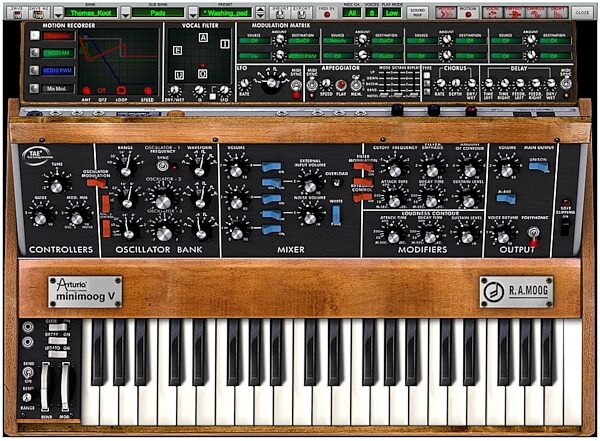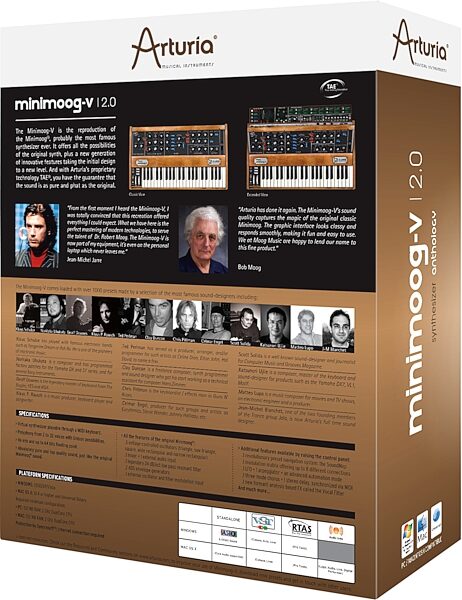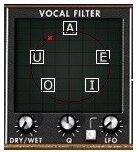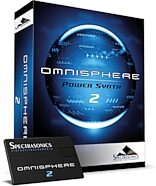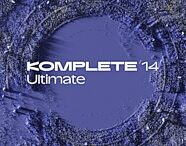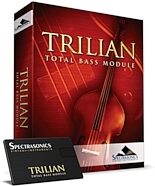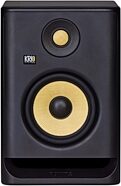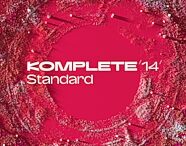Arturia Minimoog V Software Synth (Macintosh and Windows)
No longer available at zZounds

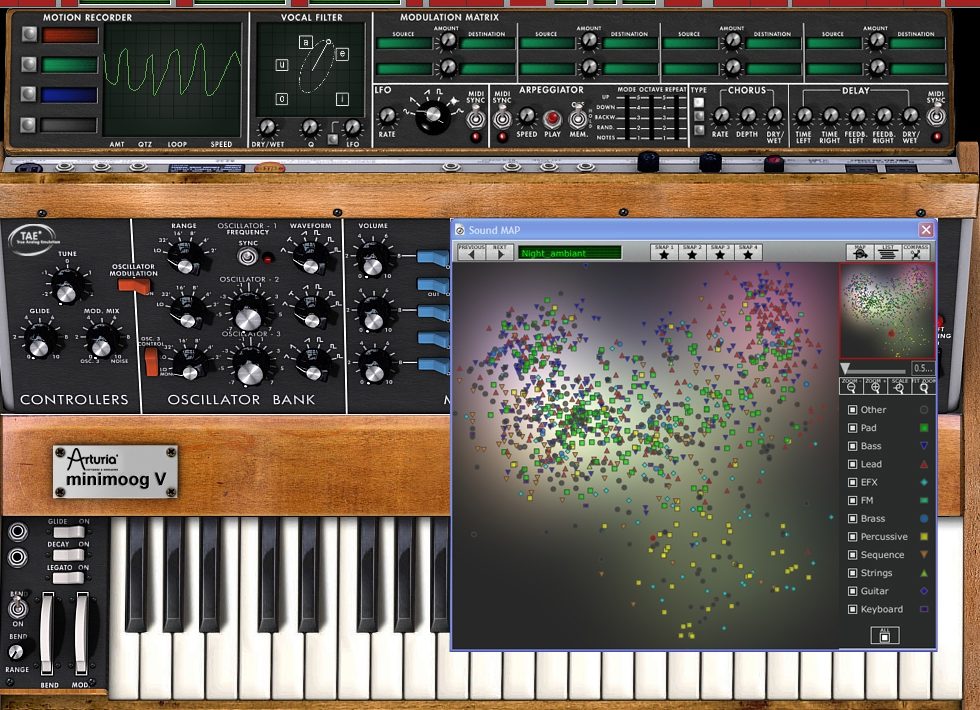



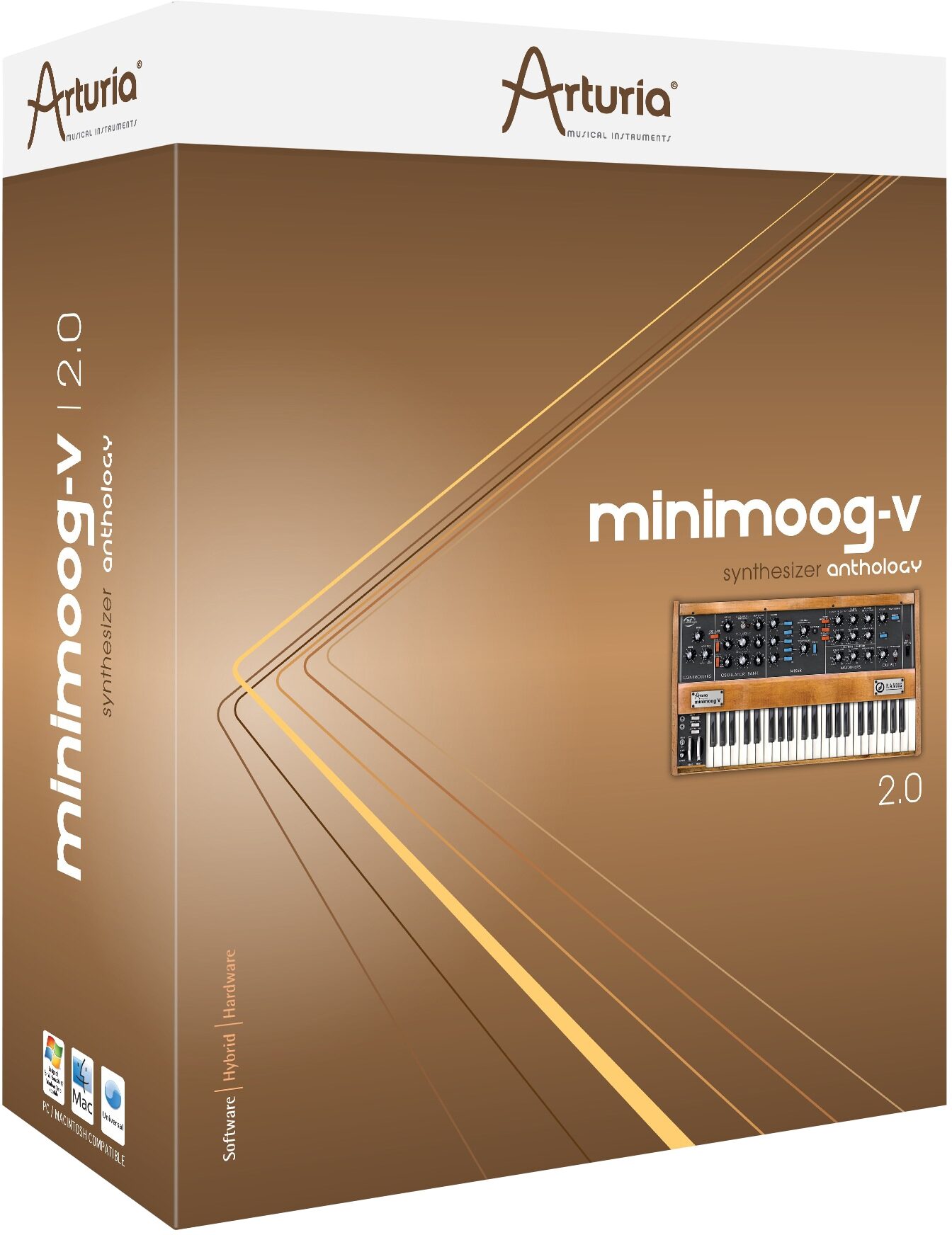

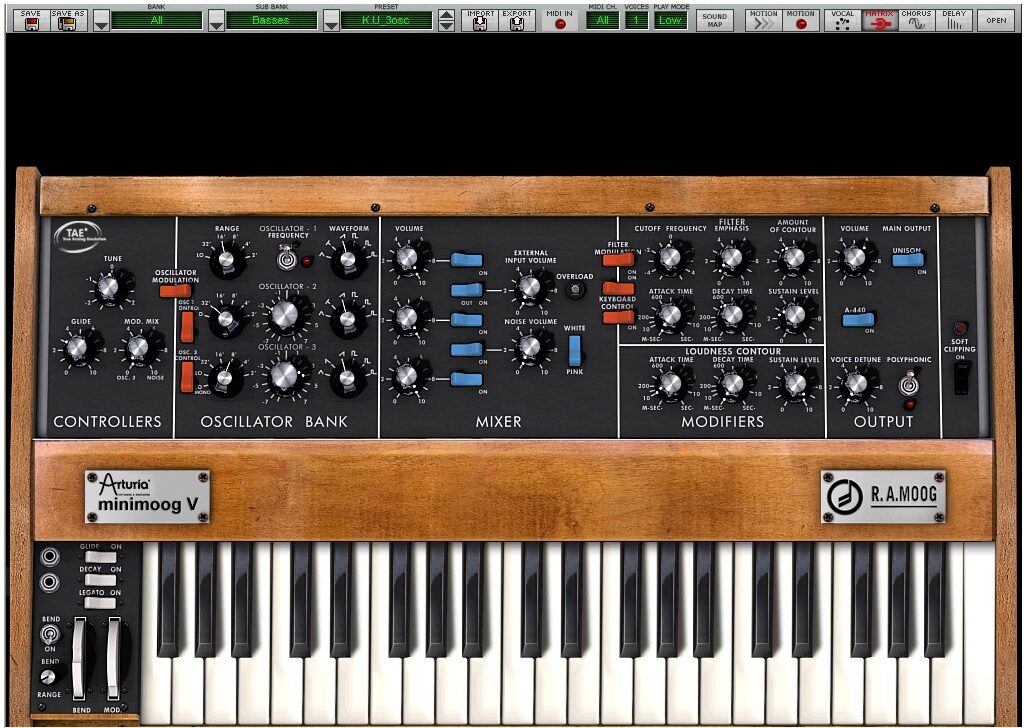
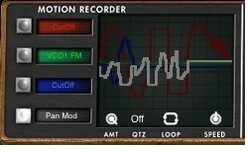

Load the same appearance and sonic possibilities of the classic minimoog on to your computer with this affordable synth software.
Overview
From the starship funk lead lines of the 70's, to the gangster whine of mid 90's hip-hop, the ever present minimoog has been making its phat presence felt for over 3 decades. In partnership with Bob Moog, Arturia decided to reproduce the legendary interface with the same look and feel than the original because of its particular "mood", and because many musicians wish to use the same interface they used in the past. But the reproduction of this synthesizer does not stop to the look and feel, Arturia also recreated its inside characteristics...
Features
- All the parameters of the original minimoog V
- Advanced automation mode (Minimoog V 2.0 Only)
- Revolutionary preset navigation system called the SoundMap (Minimoog V 2.0 Only)
- New formant-analysis-based FX called the Vocal Filter (Minimoog V 2.0 Only)
- New modulation matrix with up to 6 connections (12 sources and 32 destinations)
- New arpeggiator
- New LFO
- New Chorus and Stereo Delay Effect section
- More than 500 presets created by talented artists and sound designers
- Up to 32 voices of polyphony, and a Unison mode
- 3 voltage controlled oscillators with 5 waveforms
- 1 amazingly sounding 24 dB/octave filter
- 1 VCA
- 1 Mixer
- 1 Noise Generator
- 2 ADSR envelopes
- 1 external audio input and 1 external oscillator and filter modulation input
- Soft clipping function
- No aliasing from 0.1 Hz to 20 kHz
- 64-bit floating point precision
- Sampling rate: up to 96 kHz
Sound MAP
Explore hundreds… read more of sounds using our revolutionary Sound MAP. Locate areas you like and pick a sound that will stimulate your creativity. Morph sounds on the MAP by clicking anywhere you like. Add filters to make your search easier, or get back to the traditional list of presets, by sound-designer or by type. Be creative, be funky, be a sound-traveller.
Vocal Filter
Did you ever think of making a Minimoog talk? Well we thought of it and came with a very exciting solution called the Vocal Filter. Sonic results can be spectacular, similar to those sounds from Kubrick movies.
Circuitry improvements: While we built around the core Minimoog structure, we also added a few options in the circuits. The Keyboard Follow can now be deactivated on VCO2. In addition, Arturia extended the modulation matrix and added a few sources and destinations. The Pan and Vocal Filter can now be used as destinations. Two random signals based on a Sample & Hold are added as inputs. We also allowed for using the voice number (from the polyphonic range) as a discreet source, which proved very interesting to control different parameters.
Automation
What if a Minimoog offered automation - not as a control option but as a sound-design tool? Pick up to four parameters and record realtime changes within the preset. This is an entirely new sound palette that will arise, just by the traditional Minimoog scenery.
What Arturia Added
We added some very useful enhancements to the original minimoog, of course - polyphony, and many other simple and powerful features.
Polyphony - that's what a generation of minimoog users dreamt of! But today all soft synthesizers are polyphonic - so we bring this to you in the minimoogV.
Arturia also added more features, always with keeping in mind the original simplicity of the Minimoog.
- Delay & chorus: simple parameters, but rich sound. The chorus sound was carefully evaluated and improved to have a "creamy" sound without blurring natural attack and transients of the minimoog sound.
- Modulation matrix: it allows you to connect many midi controllers to any of the modulable parameters of the instrument. So you can have a live control of your sound.
- LFO: an extra oscillator was added for modulation purposes. You can connect this LFO to any modulable parameter via the modulation matrix and free up the minimoogV's third oscilators to add to the sound or for other modulation possibilities.
- Arpeggiator: it allows the keyboardist to have automatic note sequencing of a chord. With this feature you can simply play and hold notes on your keyboard and obtain many special effects and note patterns.
- PWM: oscillators can be modulated in pulse width, which is a unique feature of the minimoog V, and which cannot be found on any other minimoog emulation on the market. This allows for a new level of tone control of the oscillators, and allows you to make sounds that are otherwise impossible on a minimoog.
What Can You Do with the miniMoog V?
You can make a large range of sound with the minimoogV. This instrument is particularly efficient and simple for bass and leads. Inserting a minimoog V sound into your mix is fast and easy.
You can pick up one of the 300 provided presets, made by renowned sound designers and begin to play. All parameters are directly accessible, so you can tweak the sound to easily fit in your song.
But for what kind of sound the minimoog is the best? Every minimoog owner will say "BASS". In fact the minimoog was mainly used for bass and lead sounds, because it was monophonic. But it is not the only reason. Its simple but efficient architecture, the specific shape of the filter, the characteristics of oscillators and the soft clipping output stage give the minimoog a warm and unique sound. The minimoog V reproduces this unique warm sound, and that's why you can play this kind of powerful, loud basses with this instrument.
The lead sounds are also as clear as with the original minimoog, with the glide portamento and its very particular envelope response which makes its sound more playable.
But you can do more! With its polyphonic capability, arpeggiator, modulation matrix and effects, you can make an incredible array of sounds, all while keeping the ease of use and true sound of the minimoog architecture.
A Little Bit of History
"Here it is! A compact, moderately priced electronic music synthesizer designed for live performance." This is the way the Minimoog is introduced on the very first promotional brochure, in the midst of 1971.
The Minimoog synthesizer required several months of research and development and 4 prototypes, before leading to the commercial model. More than 12,000 units were sold until 1981. They were quite far from the 10 modular units per month that Moog Music produced in the late 60's.
The very first Minimoog prototype was called Model A. Three other versions, B, C and D, followed. This last model is the final and most common incarnation of the Minimoog synthesizer and the only one that was put into production in large numbers. The choice of wood rather than plastic for the cabinet prevailed from the beginning, simply because Robert Moog preferred to follow the advice of musician friends, rather than drawings coming from Moog's industrial engineers. The Model D was first introduced at the NAMM convention in June 1971. It was Moog's first exposure to the music instruments industry - and the industry's first exposure to synthesizers. The reception is rather cold as, according Robert Moog himself, Most dealers didn't know what to make of a musical instrument with words like Oscillator Bank and Filter printed on the front panel.
The Minimoog knew an unparalleled success during the 1970's. Artists and bands like Tangerine Dream, Kraftwerk, Depeche Mode, Keith Emerson, Jean-Michel Jarre, Klaus Schulze, and Rick Wakeman used the synthesizer, notably for the typical sound and its very warm quality, which is excellent for basses and lead sounds. read less
Features
- All the parameters of the original minimoog V
- Advanced automation mode (Minimoog V 2.0 Only)
- Revolutionary preset navigation system called the SoundMap (Minimoog V 2.0 Only)
- New formant-analysis-based FX called the Vocal Filter (Minimoog V 2.0 Only)
- New modulation matrix with up to 6 connections (12 sources and 32 destinations)
- New arpeggiator
- New LFO
- New Chorus and Stereo Delay Effect section
- More than 500 presets created by talented artists and sound designers
- Up to 32 voices of polyphony, and a Unison mode
- 3 voltage controlled oscillators with 5 waveforms
- 1 amazingly sounding 24 dB/octave filter
- 1 VCA
- 1 Mixer
- 1 Noise Generator
- 2 ADSR envelopes
- 1 external audio input and 1 external oscillator and filter modulation input
- Soft clipping function
- No aliasing from 0.1 Hz to 20 kHz
- 64-bit floating point precision
- Sampling rate: up to 96 kHz
New in MiniMoog Version 2.0
Sound MAP
Explore hundreds… read more of sounds using our revolutionary Sound MAP. Locate areas you like and pick a sound that will stimulate your creativity. Morph sounds on the MAP by clicking anywhere you like. Add filters to make your search easier, or get back to the traditional list of presets, by sound-designer or by type. Be creative, be funky, be a sound-traveller.
Vocal Filter
Did you ever think of making a Minimoog talk? Well we thought of it and came with a very exciting solution called the Vocal Filter. Sonic results can be spectacular, similar to those sounds from Kubrick movies.
Circuitry improvements: While we built around the core Minimoog structure, we also added a few options in the circuits. The Keyboard Follow can now be deactivated on VCO2. In addition, Arturia extended the modulation matrix and added a few sources and destinations. The Pan and Vocal Filter can now be used as destinations. Two random signals based on a Sample & Hold are added as inputs. We also allowed for using the voice number (from the polyphonic range) as a discreet source, which proved very interesting to control different parameters.
Automation
What if a Minimoog offered automation - not as a control option but as a sound-design tool? Pick up to four parameters and record realtime changes within the preset. This is an entirely new sound palette that will arise, just by the traditional Minimoog scenery.
What Arturia Added
We added some very useful enhancements to the original minimoog, of course - polyphony, and many other simple and powerful features.
Polyphony - that's what a generation of minimoog users dreamt of! But today all soft synthesizers are polyphonic - so we bring this to you in the minimoogV.
Arturia also added more features, always with keeping in mind the original simplicity of the Minimoog.
- Delay & chorus: simple parameters, but rich sound. The chorus sound was carefully evaluated and improved to have a "creamy" sound without blurring natural attack and transients of the minimoog sound.
- Modulation matrix: it allows you to connect many midi controllers to any of the modulable parameters of the instrument. So you can have a live control of your sound.
- LFO: an extra oscillator was added for modulation purposes. You can connect this LFO to any modulable parameter via the modulation matrix and free up the minimoogV's third oscilators to add to the sound or for other modulation possibilities.
- Arpeggiator: it allows the keyboardist to have automatic note sequencing of a chord. With this feature you can simply play and hold notes on your keyboard and obtain many special effects and note patterns.
- PWM: oscillators can be modulated in pulse width, which is a unique feature of the minimoog V, and which cannot be found on any other minimoog emulation on the market. This allows for a new level of tone control of the oscillators, and allows you to make sounds that are otherwise impossible on a minimoog.
What Can You Do with the miniMoog V?
You can make a large range of sound with the minimoogV. This instrument is particularly efficient and simple for bass and leads. Inserting a minimoog V sound into your mix is fast and easy.
You can pick up one of the 300 provided presets, made by renowned sound designers and begin to play. All parameters are directly accessible, so you can tweak the sound to easily fit in your song.
But for what kind of sound the minimoog is the best? Every minimoog owner will say "BASS". In fact the minimoog was mainly used for bass and lead sounds, because it was monophonic. But it is not the only reason. Its simple but efficient architecture, the specific shape of the filter, the characteristics of oscillators and the soft clipping output stage give the minimoog a warm and unique sound. The minimoog V reproduces this unique warm sound, and that's why you can play this kind of powerful, loud basses with this instrument.
The lead sounds are also as clear as with the original minimoog, with the glide portamento and its very particular envelope response which makes its sound more playable.
But you can do more! With its polyphonic capability, arpeggiator, modulation matrix and effects, you can make an incredible array of sounds, all while keeping the ease of use and true sound of the minimoog architecture.
A Little Bit of History
"Here it is! A compact, moderately priced electronic music synthesizer designed for live performance." This is the way the Minimoog is introduced on the very first promotional brochure, in the midst of 1971.
The Minimoog synthesizer required several months of research and development and 4 prototypes, before leading to the commercial model. More than 12,000 units were sold until 1981. They were quite far from the 10 modular units per month that Moog Music produced in the late 60's.
The very first Minimoog prototype was called Model A. Three other versions, B, C and D, followed. This last model is the final and most common incarnation of the Minimoog synthesizer and the only one that was put into production in large numbers. The choice of wood rather than plastic for the cabinet prevailed from the beginning, simply because Robert Moog preferred to follow the advice of musician friends, rather than drawings coming from Moog's industrial engineers. The Model D was first introduced at the NAMM convention in June 1971. It was Moog's first exposure to the music instruments industry - and the industry's first exposure to synthesizers. The reception is rather cold as, according Robert Moog himself, Most dealers didn't know what to make of a musical instrument with words like Oscillator Bank and Filter printed on the front panel.
The Minimoog knew an unparalleled success during the 1970's. Artists and bands like Tangerine Dream, Kraftwerk, Depeche Mode, Keith Emerson, Jean-Michel Jarre, Klaus Schulze, and Rick Wakeman used the synthesizer, notably for the typical sound and its very warm quality, which is excellent for basses and lead sounds. read less
Specs
Required Minimum Configuration
Windows: Windows 2000/XP/Vista -- 512 MB RAM; 2 Ghz DualCore CPU
Mac: Mac OS X 10.4 or higher and Universal Binary -- 512 MB RAM; 2 Ghz DualCore CPU
Sound Card: Any sound card compatible with DirectX, ASIO, SoundManager or CoreAudio
A 230-paged paper manual is provided in 3 languages: French, English and Japanese.
Copy protection: the installation CD is only required each time you want to import new banks of presets or when you install an update patch of the product.
Minimoog V 2.0 is protected by Syncrosoft.
This is a free upgrade for 1.6 owners. You'll be able to download your Minimoog V 2.0 and request your Syncrosoft Activation code. A short online guide will help you in upgrading your product.
Windows: Windows 2000/XP/Vista -- 512 MB RAM; 2 Ghz DualCore CPU
Mac: Mac OS X 10.4 or higher and Universal Binary -- 512 MB RAM; 2 Ghz DualCore CPU
Sound Card: Any sound card compatible with DirectX, ASIO, SoundManager or CoreAudio
A 230-paged paper manual is provided in 3 languages: French, English and Japanese.
Copy protection: the installation CD is only required each time you want to import new banks of presets or when you install an update patch of the product.
Minimoog V 2.0 is protected by Syncrosoft.
This is a free upgrade for 1.6 owners. You'll be able to download your Minimoog V 2.0 and request your Syncrosoft Activation code. A short online guide will help you in upgrading your product.
Documents and Manuals
For support or warranty questions, please contact the manufacturer:
Web: https://www.arturia.com/support
Web: https://www.arturia.com/support
Reviews
Submitted March 26, 2007
"Real Moog for 10X less"
The best Minimoog emulation i have ever heard to this day.
Sound
The new and update version of this beast is hands down amazing. The sound is nothing short of the classic moog sound we all love. I was going to buy the gforce minimonsta and after a week on demo, i was not so impressed with the emualtion. It was not far off from the moog sound but not as analog like as the Minimoog V. I really like how the sound of the Arturia minimoog has a living character, it has a sound that vibrates and moves. This reminds me of real analog sound, not the plastic we listen to on many soft synths. The minimoog v also responds very well to controls and syncs perfect with playback on the daw, unlike the minimonsta, which constantly caused audio drop outs. Overall i think the minimoog v sounds as good as it gets when it comes to software emaulations of the moog sound.
Features
Same as the real Minimoog, plus extras like fx, poly mode, matrix, and multiple instances. This makes Minimoog V even more pleasing to use, as it is identical to the control panel of the real thing.
Ease of Use
Very easy once you get past basic synthesis.
Quality
Top sound, amazing moog filter...period.
Value
Well worth the dough, if like moog synths. this is a real moog, more than 10 times cheaper.
Manufacturer Support
Average, not brilliant,… read more but not that bad either.
The Wow Factor
Looks great, and makes you feel like you have a vintage synth inside your cpu. Aside looks, the sound is the most important part, and it doesn't fail.
read less
Sound
The new and update version of this beast is hands down amazing. The sound is nothing short of the classic moog sound we all love. I was going to buy the gforce minimonsta and after a week on demo, i was not so impressed with the emualtion. It was not far off from the moog sound but not as analog like as the Minimoog V. I really like how the sound of the Arturia minimoog has a living character, it has a sound that vibrates and moves. This reminds me of real analog sound, not the plastic we listen to on many soft synths. The minimoog v also responds very well to controls and syncs perfect with playback on the daw, unlike the minimonsta, which constantly caused audio drop outs. Overall i think the minimoog v sounds as good as it gets when it comes to software emaulations of the moog sound.
Features
Same as the real Minimoog, plus extras like fx, poly mode, matrix, and multiple instances. This makes Minimoog V even more pleasing to use, as it is identical to the control panel of the real thing.
Ease of Use
Very easy once you get past basic synthesis.
Quality
Top sound, amazing moog filter...period.
Value
Well worth the dough, if like moog synths. this is a real moog, more than 10 times cheaper.
Manufacturer Support
Average, not brilliant,… read more but not that bad either.
The Wow Factor
Looks great, and makes you feel like you have a vintage synth inside your cpu. Aside looks, the sound is the most important part, and it doesn't fail.
read less
19 of 23 people (83%) people found this review helpful. Did you?
Thanks for your opinion!
No longer available at zZounds
In most cases, a product is unavailable because it has been discontinued by the manufacturer
This is a carousel with product cards. Use the previous and next buttons to navigate.


